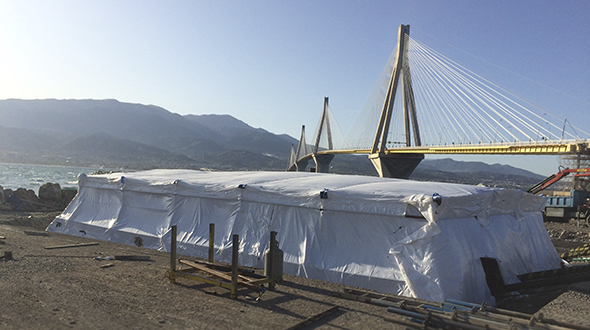In addition to the planning, manufacture and delivery of the joints and outdoor terminations, PFISTERER is also responsible for their installation by its own EHV specialist installers. The work will be finished by the end of March 2020.
A new land-sea cable connection in the Strait of Rio-Antirrio near Patras will in future improve the connection of the Peloponnese to the 400 kV grid in central Greece. Together with Hellenic Cables, PFISTERER is ensuring safe connection with IXOSIL high-voltage joints and outdoor terminations. The two companies are linked by a long-standing partnership, as Eduardo Santana, Director of PFISTERER’s PTS Cable business unit, emphasises: “Hellenic Cables as a manufacturer of power cables and PFISTERER as an independent expert in cable fittings have always shared the same philosophy of implementing technical maxims for our clients and making a decisive contribution as a team to the overall success of such projects.” The client for the current project for the further expansion of the 400 kV grid is the energy utility IPTO, a subsidiary of PPC, the largest energy supplier in Greece.
Safe transitions despite different cable diameters
The basis for the new EHV link on the west coast of the Peloponnese is formed by two three-phase submarine cables. These are connected to the land cables on both shores with PFISTERER IXOSIL transition joints (land/sea cables). Further joints follow at intervals of 300 to 800 m. When connecting sea and land cables, the IXOSIL joints with SICON connectors also ensure a safe transition between the different cable diameters of 1,200 mm2 for the sea cable and 2,500 mm2 for the land cable. For checks and function monitoring purposes, one phase of the sea cable and one phase of the land cable are equipped with a fibre optic conductor.
While the EHV connection in the Strait of Rio-Antirrio uses XLPE cables of the same kind, the PFISTERER fittings are generally universally applicable and compatible with XLPE cables from all suppliers. In addition to planning, manufacture and delivery, PFISTERER is also responsible for the installation of the joints and outdoor terminations by its own EHV specialist installers. The joints are placed on land in ducts and then buried. The area of the Gulf of Patras is considered seismically active, especially as the 65 metre deep strait lies on a tectonic fault zone. A challenge for all infrastructural facilities, which must be built to withstand earthquakes.
Tested for increased requirements for Greece
Planning for the land-sea cable connection began around five years ago, and a year ago Hellenic Cables and PFISTERER were awarded the contract for joint implementation. The two partners have been working together successfully in joint MV, HV and EHV projects for around 15 years, mainly in Europe, but also internationally. The 420 kV fittings from PFISTERER underwent cable-specific system testing with Hellenic Cables in accordance with IEC 62067 in 2016. “For qualification purposes, the CONNEX and IXOSIL fittings were also tested at 230 kV instead of the usual phase-to-earth voltage of 220 kV in accordance with the higher requirements of the Greek network operator. The lightning impulse tests were increased from 1,425 kV to 1,550 kV. The PFISTERER systems passed all the tests with flying colours – an important prerequisite for the current EHV project,” reports Lambros Papadias, PFISTERER Delegate for Greece and neighbouring Balkan countries. PFISTERER is currently one of the few suppliers of fittings worldwide that can show it has passed this test successfully.
